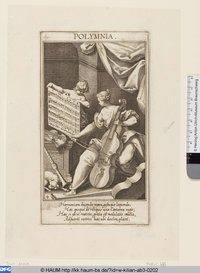
"Polyhymnia (/pɒliˈhɪmniə/; Greek: Πολυύμνια, lit. 'the one of many hymns'), alternatively Polymnia (Πολύμνια) was in Greek mythology the Muse of sacred poetry, sacred hymn, dance, and eloquence as well as agriculture and pantomime. Her name comes from the Greek words "poly" meaning "many" and "hymnos", which means "praise". She is depicted as very serious, pensive and meditative, and often holding a finger to her mouth, dressed in a long cloak and veil and resting her elbow on a pillar. Polyhymnia is also sometimes credited as being the Muse of geometry and meditation." - (en.wikipedia.org 22.12.2020)





![Minerva visiting the Muses [Besuch der Minerva bei den Musen]](/data/nds/resources/images/202009/200w_000001-5f5857ea3174c.jpg)